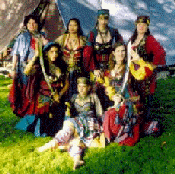WORLD'S HIGHEST PREVALENCE
 The community with the world's highest prevalence of Parkinson's Disease is along the River Nile in Egypt amongst the rural illiterate Egyptians. They have a prevalence rate of 1,103 per 100,000. This difference is probably related to poverty rather than literacy. In some of the villages south of Cairo there are only mud roads and open sewers. With a prevalence rate of 557 per 100,000, Egypt is the country with the world's second highest prevalence of Parkinson's Disease.
The community with the world's highest prevalence of Parkinson's Disease is along the River Nile in Egypt amongst the rural illiterate Egyptians. They have a prevalence rate of 1,103 per 100,000. This difference is probably related to poverty rather than literacy. In some of the villages south of Cairo there are only mud roads and open sewers. With a prevalence rate of 557 per 100,000, Egypt is the country with the world's second highest prevalence of Parkinson's Disease.
The world's second highest prevalence of Parkinson's Disease by far has been found among the Amish community. The Amish are a devoutly religious community, primarily in the North East of the U.S.A., who believe in the literal interpretation of the Bible. The prevalence of Parkinson's Disease amongst the Amish community is 970 per 100,000, which is enormously high. They are afflicted by genetic disorders. So it was thought that the cause might be genetic. However, the more closely related they were, the less they were affected. They are primarily involved in agriculture, and most of them use pesticides, but the effect of pesticides was not assessed by the researchers.
interpretation of the Bible. The prevalence of Parkinson's Disease amongst the Amish community is 970 per 100,000, which is enormously high. They are afflicted by genetic disorders. So it was thought that the cause might be genetic. However, the more closely related they were, the less they were affected. They are primarily involved in agriculture, and most of them use pesticides, but the effect of pesticides was not assessed by the researchers.

The world's highest prevalence
of Parkinson's Disease of any country is Albania.
The prevalence figures for Parkinsonism were found to be 800 per 100,000. Parkinsonism includes some other disorders. So the Albanian figure for only Parkinson's Disease would be lower, but still far higher than any other country. The prevalence of neurological disorders in Albania was found to be high generally.
 The world's next highest prevalence of Parkinson's Disease is in the vicinities of ferromanganese plants near Brescia in Italy, with 407 people per 100,000 population. Manganese concentrations in settled dust were found to be significantly higher in the surroundings and downwind from the ferromanganese plants. In high concentrations, manganese is a known cause of Parkinson's Disease.
The world's next highest prevalence of Parkinson's Disease is in the vicinities of ferromanganese plants near Brescia in Italy, with 407 people per 100,000 population. Manganese concentrations in settled dust were found to be significantly higher in the surroundings and downwind from the ferromanganese plants. In high concentrations, manganese is a known cause of Parkinson's Disease.
 Native Americans, including American Indian and Alaska Native peoples have a prevalence rate of 355 per 100,000, which is well beyond that of the general population. The highest prevalence rate of any region of North America is Nebraska, in the U.S.A. with 329.3 people per 100,000 population having Parkinson's Disease. It is possible that the very high number in Nebraska is due to the heavy use of insecticides in what is largely a farming area.
Native Americans, including American Indian and Alaska Native peoples have a prevalence rate of 355 per 100,000, which is well beyond that of the general population. The highest prevalence rate of any region of North America is Nebraska, in the U.S.A. with 329.3 people per 100,000 population having Parkinson's Disease. It is possible that the very high number in Nebraska is due to the heavy use of insecticides in what is largely a farming area.
 The Parsi community of Mumbai, India have a prevalence of Parkinson's Disease of 328 per 100,000 population, which is almost in excess of that found in Nebraska. This is despite India as a whole having a low prevalence. The Parsi practice Zoroastrianism, a religion based on the teachings of Zoroaster. As part of their religion, the Parsis burn Aspand seeds to rid their children of the Evil Eye, which is the name for a sickness transmitted by someone who is envious, jealous, or covetous. The fumes are often inhaled. Aspand seed is the richest natural source of harmine and harmaline. They are a type of drug known as MAO Inhibitors, which are used in Parkinson's Disease. Long term use of MAO inhibitors eventually has the opposite effect and so may cause the high prevalence of Parkinson's Disease amongst the Parsi.
The Parsi community of Mumbai, India have a prevalence of Parkinson's Disease of 328 per 100,000 population, which is almost in excess of that found in Nebraska. This is despite India as a whole having a low prevalence. The Parsi practice Zoroastrianism, a religion based on the teachings of Zoroaster. As part of their religion, the Parsis burn Aspand seeds to rid their children of the Evil Eye, which is the name for a sickness transmitted by someone who is envious, jealous, or covetous. The fumes are often inhaled. Aspand seed is the richest natural source of harmine and harmaline. They are a type of drug known as MAO Inhibitors, which are used in Parkinson's Disease. Long term use of MAO inhibitors eventually has the opposite effect and so may cause the high prevalence of Parkinson's Disease amongst the Parsi.
WORLD'S LOWEST PREVALENCE
 Ethiopia has the world's lowest recorded prevalence of Parkinson's Disease. At a rate of only 7 per 100,000 it is far below the world's highest prevalence rate of 329 per 100,000 in Nebraska, U.S.A.. As Parkinson's Disease tends to be more common in older people, the very low prevalence in Ethiopia may result from the very low life expectancy in Ethiopia. Few prevalence studies have been carried out in African countries. For most African countries the figures are not known. If they were, other countries in the same region as Ethiopia, or even in other parts of Africa may produce even lower prevalence figures than those of Ethiopia.
Ethiopia has the world's lowest recorded prevalence of Parkinson's Disease. At a rate of only 7 per 100,000 it is far below the world's highest prevalence rate of 329 per 100,000 in Nebraska, U.S.A.. As Parkinson's Disease tends to be more common in older people, the very low prevalence in Ethiopia may result from the very low life expectancy in Ethiopia. Few prevalence studies have been carried out in African countries. For most African countries the figures are not known. If they were, other countries in the same region as Ethiopia, or even in other parts of Africa may produce even lower prevalence figures than those of Ethiopia.
PREVALENCE BY COUNTRY
The prevalence for each country per 100,000 of population, in those countries in which it is known, from highest to lowest is : Albania 800, Egypt 557, U.S.A. 329-107, Canada 317-167, Israel 256, Japan 193 - 76, San Marino 185, Faeroe Islands 206-183, Japan 192 - 76, Germany 183, Spain 170-122,  Italy 168-104, Finland 166-120, Bulgaria 164-137, Estonia 152, Australia 146-104, Wales 142, England 139-121, Portugal 135, Cuba 135, Canada 125, China 119-57, Scotland 129, Norway 102, Thailand 95, Sweden 76, New Zealand 76, Nigeria 67, Poland 66, Jordan 59, Bolivia 50, Libya 31, Colombia 31, Tanzania 20, Korea 19, Ethiopia 7. The prevalence differs from country to country and can even differ within countries. The prevalence amongst Bulgarian Gypsies is only one tenth of that found amongst other Bulgarians. The prevalence in the U.S.A. tends to differ according to race, with Hispanics, then Whites, then Asians, then Blacks being more prone. Other studies have given different results.
Italy 168-104, Finland 166-120, Bulgaria 164-137, Estonia 152, Australia 146-104, Wales 142, England 139-121, Portugal 135, Cuba 135, Canada 125, China 119-57, Scotland 129, Norway 102, Thailand 95, Sweden 76, New Zealand 76, Nigeria 67, Poland 66, Jordan 59, Bolivia 50, Libya 31, Colombia 31, Tanzania 20, Korea 19, Ethiopia 7. The prevalence differs from country to country and can even differ within countries. The prevalence amongst Bulgarian Gypsies is only one tenth of that found amongst other Bulgarians. The prevalence in the U.S.A. tends to differ according to race, with Hispanics, then Whites, then Asians, then Blacks being more prone. Other studies have given different results.
NCIDENCE RATES
The rate at which people with Parkinson's Disease are newly diagnosed differs greatly according to the country. The incidence for each country, in which it is known, per 100,000 of population per year from highest to lowest is :Sweden 22.5-7.9, Faeroe Islands 21.1, U.S.A. 20.5-13.0, Japan 16.9 - 10.2, Estonia 16.8, Finland 16.6-14.9, Norway 12.6, England 12, Bulgaria 11.6, Netherlands 11.5, Italy 10.1, Russia 9.0, Libya 4.5.
AGE DISTRIBUTION
In 1875, Henri Huchard (1844-1911) detailed the first case of Juvenile Parkinson's Disease. He described a 3 year old child who had all the clinical features of Parkinson's Disease. The youngest reported case of Parkinson's Diseasesince then is that of a 10 year old girl from Okalahoma, who showed her first symptoms of Parkinson's Disease at only 2 years old. However, it is very uncommon for people under the age of 30 to develop Parkinson's Disease. Parkinson's Disease usually occurs when people are significantly older than that and becomes increasingly more common with age. The average age at which symptoms usually begin differs from county to country, with the oldest average onset being in Sweden 65.6, and Estonia 66.9.The likelihood of Parkinson's Disease increases sharply at the age of 60, and peaks in those aged 85 to 89 years old. The likelihood of developing Parkinson's Disease starts to decline at 90 years of age, and reduces even further after that. Parkinson's Disease is rare amongst the very old - those people over 100, and even in those people who are 110 to 119 years old.
only 2 years old. However, it is very uncommon for people under the age of 30 to develop Parkinson's Disease. Parkinson's Disease usually occurs when people are significantly older than that and becomes increasingly more common with age. The average age at which symptoms usually begin differs from county to country, with the oldest average onset being in Sweden 65.6, and Estonia 66.9.The likelihood of Parkinson's Disease increases sharply at the age of 60, and peaks in those aged 85 to 89 years old. The likelihood of developing Parkinson's Disease starts to decline at 90 years of age, and reduces even further after that. Parkinson's Disease is rare amongst the very old - those people over 100, and even in those people who are 110 to 119 years old.
GENDER DIFFERENCES
There are more men than women with Parkinson's Disease. However, the ratio of males to females differs a lotaccording to the country. There is a stark contrast between a clear male dominance in Nigeria, and Japan, where far more Japanese women than men have Parkinson's Disease. The ratio of males to females, in those countries in which it is known, from highest to lowest is : Nigeria 3.3, Tanzania 2.72, Spain 2.55-2.06, Taiwan 2.4, U.S.A. 1.9-1.0, Finland 1.7, Norway 1.58-1.35, Canada 1.56, Netherlands 1.54, France 1.4, Canada 1.2-1.16, Portugal 1.08, San Marino 1.0, Sweden > 1.0, Argentina > 1.0, Estonia < 1.0, Finland < 1.0, Italy 0.98, Netherlands 1.0-0.92, Russia 0.87, Japan 0.71 - 0.67.
more Japanese women than men have Parkinson's Disease. The ratio of males to females, in those countries in which it is known, from highest to lowest is : Nigeria 3.3, Tanzania 2.72, Spain 2.55-2.06, Taiwan 2.4, U.S.A. 1.9-1.0, Finland 1.7, Norway 1.58-1.35, Canada 1.56, Netherlands 1.54, France 1.4, Canada 1.2-1.16, Portugal 1.08, San Marino 1.0, Sweden > 1.0, Argentina > 1.0, Estonia < 1.0, Finland < 1.0, Italy 0.98, Netherlands 1.0-0.92, Russia 0.87, Japan 0.71 - 0.67.
RACIAL DIFFERENCES
Racial differences are best assessed in the same country in order to nullify other factors. In the U.S.A., the proneness to Parkinson's Disease was highest amongst whites, with an incidence of 45 per 100,000. Latinos were the next most prone with an incidence of 40 per 100,000. Least prone of all were African-Americans with an incidence

of only 23 per 100,000. This gave African-Americans only a 43% chance of being diagnosed in comparison to whites. Even after adjusting for all possible factors, African-Americans still had less than half the likelihood of developing Parkinson's Disease. The reason for this racial difference in Parkinson's Disease is unknown. Observed racial differences in the incidence of Parkinson's Disease are not explained at all by differences in age, sex, income, insurance or healthcare utilization. In another study the prevalence in the U.S.A., proneness to Parkinson's Disease was also found to differ according to race, but with Hispanics, then Whites, then Asians, then Blacks being more prone. Other studies have given different results.
HAIR COLOUR
The risk of Parkinson's Disease increases according to hair colour. People with black hair were found to be least prone to Parkinson's Disease. People with brown hair were 40% more likely to develop Parkinson's Disease. People

with blonde hair were found to be around 60% more likely to develop Parkinson's Disease. Worst at risk were people with red hair, for whom the risk of Parkinson's Disease is nearly doubled. At first this association seems odd, but hair colour and Parkinson's Disease share a common biochemistry. The dopamine needed to relieve Parkinson's Disease is initially made from L-tyrosine turning in to L-dopa. Coincidentally, Melanin, the pigment that colours hair is also initially made by turning L-tyrosine in to L-dopa.
OCCUPATIONAL DIFFERENCES
Parkinson's Disease was found to be far more common amongst welders.
Prevalence was also significantly higher amongst physicians, dentists, teachers, lawyers, scientists, and religion-related jobs. Computer programmers had ayounger age at PD diagnosis, and risk of diagnosis. Clerical occupations were also positively associated withParkinson's Disease. Those people involved in manufacturing and transportation were less likely to get Parkinson's Disease. Agricultural workers were more prone to Parkinson's Disease as were those involved in hunting and forestry. Parkinson's Disease is more common in rural areas, but it differs according to the country. The ratio of rural to urban cases, in those countries in which it is known, from highest to lowest is : Italy 2.03-1.14, Estonia 1.14, Sweden 1.3. However, another study found that the risk of Parkinson's Disease was not significantly affected by farming work, by metal work, or by exposure to pesticides, metals, or solvents.
Disease. Agricultural workers were more prone to Parkinson's Disease as were those involved in hunting and forestry. Parkinson's Disease is more common in rural areas, but it differs according to the country. The ratio of rural to urban cases, in those countries in which it is known, from highest to lowest is : Italy 2.03-1.14, Estonia 1.14, Sweden 1.3. However, another study found that the risk of Parkinson's Disease was not significantly affected by farming work, by metal work, or by exposure to pesticides, metals, or solvents.
 The community with the world's highest prevalence of Parkinson's Disease is along the River Nile in Egypt amongst the rural illiterate Egyptians. They have a prevalence rate of 1,103 per 100,000. This difference is probably related to poverty rather than literacy. In some of the villages south of Cairo there are only mud roads and open sewers. With a prevalence rate of 557 per 100,000, Egypt is the country with the world's second highest prevalence of Parkinson's Disease.
The community with the world's highest prevalence of Parkinson's Disease is along the River Nile in Egypt amongst the rural illiterate Egyptians. They have a prevalence rate of 1,103 per 100,000. This difference is probably related to poverty rather than literacy. In some of the villages south of Cairo there are only mud roads and open sewers. With a prevalence rate of 557 per 100,000, Egypt is the country with the world's second highest prevalence of Parkinson's Disease. interpretation of the Bible. The prevalence of Parkinson's Disease amongst the Amish community is 970 per 100,000, which is enormously high. They are afflicted by genetic disorders. So it was thought that the cause might be genetic. However, the more closely related they were, the less they were affected. They are primarily involved in agriculture, and most of them use pesticides, but the effect of pesticides was not assessed by the researchers.
interpretation of the Bible. The prevalence of Parkinson's Disease amongst the Amish community is 970 per 100,000, which is enormously high. They are afflicted by genetic disorders. So it was thought that the cause might be genetic. However, the more closely related they were, the less they were affected. They are primarily involved in agriculture, and most of them use pesticides, but the effect of pesticides was not assessed by the researchers. The world's highest prevalence of Parkinson's Disease of any country is Albania. The prevalence figures for Parkinsonism were found to be 800 per 100,000. Parkinsonism includes some other disorders. So the Albanian figure for only Parkinson's Disease would be lower, but still far higher than any other country. The prevalence of neurological disorders in Albania was found to be high generally.
The world's highest prevalence of Parkinson's Disease of any country is Albania. The prevalence figures for Parkinsonism were found to be 800 per 100,000. Parkinsonism includes some other disorders. So the Albanian figure for only Parkinson's Disease would be lower, but still far higher than any other country. The prevalence of neurological disorders in Albania was found to be high generally. The world's next highest prevalence of Parkinson's Disease is in the vicinities of ferromanganese plants near Brescia in Italy, with 407 people per 100,000 population. Manganese concentrations in settled dust were found to be significantly higher in the surroundings and downwind from the ferromanganese plants. In high concentrations, manganese is a known cause of Parkinson's Disease.
The world's next highest prevalence of Parkinson's Disease is in the vicinities of ferromanganese plants near Brescia in Italy, with 407 people per 100,000 population. Manganese concentrations in settled dust were found to be significantly higher in the surroundings and downwind from the ferromanganese plants. In high concentrations, manganese is a known cause of Parkinson's Disease. Native Americans, including American Indian and Alaska Native peoples have a prevalence rate of 355 per 100,000, which is well beyond that of the general population. The highest prevalence rate of any region of North America is Nebraska, in the U.S.A. with 329.3 people per 100,000 population having Parkinson's Disease. It is possible that the very high number in Nebraska is due to the heavy use of insecticides in what is largely a farming area.
Native Americans, including American Indian and Alaska Native peoples have a prevalence rate of 355 per 100,000, which is well beyond that of the general population. The highest prevalence rate of any region of North America is Nebraska, in the U.S.A. with 329.3 people per 100,000 population having Parkinson's Disease. It is possible that the very high number in Nebraska is due to the heavy use of insecticides in what is largely a farming area. The Parsi community of Mumbai, India have a prevalence of Parkinson's Disease of 328 per 100,000 population, which is almost in excess of that found in Nebraska. This is despite India as a whole having a low prevalence. The Parsi practice Zoroastrianism, a religion based on the teachings of Zoroaster. As part of their religion, the Parsis burn Aspand seeds to rid their children of the Evil Eye, which is the name for a sickness transmitted by someone who is envious, jealous, or covetous. The fumes are often inhaled. Aspand seed is the richest natural source of harmine and harmaline. They are a type of drug known as MAO Inhibitors, which are used in Parkinson's Disease. Long term use of MAO inhibitors eventually has the opposite effect and so may cause the high prevalence of Parkinson's Disease amongst the Parsi.
The Parsi community of Mumbai, India have a prevalence of Parkinson's Disease of 328 per 100,000 population, which is almost in excess of that found in Nebraska. This is despite India as a whole having a low prevalence. The Parsi practice Zoroastrianism, a religion based on the teachings of Zoroaster. As part of their religion, the Parsis burn Aspand seeds to rid their children of the Evil Eye, which is the name for a sickness transmitted by someone who is envious, jealous, or covetous. The fumes are often inhaled. Aspand seed is the richest natural source of harmine and harmaline. They are a type of drug known as MAO Inhibitors, which are used in Parkinson's Disease. Long term use of MAO inhibitors eventually has the opposite effect and so may cause the high prevalence of Parkinson's Disease amongst the Parsi. Ethiopia has the world's lowest recorded prevalence of Parkinson's Disease. At a rate of only 7 per 100,000 it is far below the world's highest prevalence rate of 329 per 100,000 in Nebraska, U.S.A.. As Parkinson's Disease tends to be more common in older people, the very low prevalence in Ethiopia may result from the very low life expectancy in Ethiopia. Few prevalence studies have been carried out in African countries. For most African countries the figures are not known. If they were, other countries in the same region as Ethiopia, or even in other parts of Africa may produce even lower prevalence figures than those of Ethiopia.
Ethiopia has the world's lowest recorded prevalence of Parkinson's Disease. At a rate of only 7 per 100,000 it is far below the world's highest prevalence rate of 329 per 100,000 in Nebraska, U.S.A.. As Parkinson's Disease tends to be more common in older people, the very low prevalence in Ethiopia may result from the very low life expectancy in Ethiopia. Few prevalence studies have been carried out in African countries. For most African countries the figures are not known. If they were, other countries in the same region as Ethiopia, or even in other parts of Africa may produce even lower prevalence figures than those of Ethiopia. Italy 168-104, Finland 166-120, Bulgaria 164-137, Estonia 152, Australia 146-104, Wales 142, England 139-121, Portugal 135, Cuba 135, Canada 125, China 119-57, Scotland 129, Norway 102, Thailand 95, Sweden 76, New Zealand 76, Nigeria 67, Poland 66, Jordan 59, Bolivia 50, Libya 31, Colombia 31, Tanzania 20, Korea 19, Ethiopia 7. The prevalence differs from country to country and can even differ within countries. The prevalence amongst Bulgarian Gypsies is only one tenth of that found amongst other Bulgarians. The prevalence in the U.S.A. tends to differ according to race, with Hispanics, then Whites, then Asians, then Blacks being more prone. Other studies have given different results.
Italy 168-104, Finland 166-120, Bulgaria 164-137, Estonia 152, Australia 146-104, Wales 142, England 139-121, Portugal 135, Cuba 135, Canada 125, China 119-57, Scotland 129, Norway 102, Thailand 95, Sweden 76, New Zealand 76, Nigeria 67, Poland 66, Jordan 59, Bolivia 50, Libya 31, Colombia 31, Tanzania 20, Korea 19, Ethiopia 7. The prevalence differs from country to country and can even differ within countries. The prevalence amongst Bulgarian Gypsies is only one tenth of that found amongst other Bulgarians. The prevalence in the U.S.A. tends to differ according to race, with Hispanics, then Whites, then Asians, then Blacks being more prone. Other studies have given different results. only 2 years old. However, it is very uncommon for people under the age of 30 to develop Parkinson's Disease. Parkinson's Disease usually occurs when people are significantly older than that and becomes increasingly more common with age. The average age at which symptoms usually begin differs from county to country, with the oldest average onset being in Sweden 65.6, and Estonia 66.9.The likelihood of Parkinson's Disease increases sharply at the age of 60, and peaks in those aged 85 to 89 years old. The likelihood of developing Parkinson's Disease starts to decline at 90 years of age, and reduces even further after that. Parkinson's Disease is rare amongst the very old - those people over 100, and even in those people who are 110 to 119 years old.
only 2 years old. However, it is very uncommon for people under the age of 30 to develop Parkinson's Disease. Parkinson's Disease usually occurs when people are significantly older than that and becomes increasingly more common with age. The average age at which symptoms usually begin differs from county to country, with the oldest average onset being in Sweden 65.6, and Estonia 66.9.The likelihood of Parkinson's Disease increases sharply at the age of 60, and peaks in those aged 85 to 89 years old. The likelihood of developing Parkinson's Disease starts to decline at 90 years of age, and reduces even further after that. Parkinson's Disease is rare amongst the very old - those people over 100, and even in those people who are 110 to 119 years old. more Japanese women than men have Parkinson's Disease. The ratio of males to females, in those countries in which it is known, from highest to lowest is : Nigeria 3.3, Tanzania 2.72, Spain 2.55-2.06, Taiwan 2.4, U.S.A. 1.9-1.0, Finland 1.7, Norway 1.58-1.35, Canada 1.56, Netherlands 1.54, France 1.4, Canada 1.2-1.16, Portugal 1.08, San Marino 1.0, Sweden > 1.0, Argentina > 1.0, Estonia < 1.0, Finland < 1.0, Italy 0.98, Netherlands 1.0-0.92, Russia 0.87, Japan 0.71 - 0.67.
more Japanese women than men have Parkinson's Disease. The ratio of males to females, in those countries in which it is known, from highest to lowest is : Nigeria 3.3, Tanzania 2.72, Spain 2.55-2.06, Taiwan 2.4, U.S.A. 1.9-1.0, Finland 1.7, Norway 1.58-1.35, Canada 1.56, Netherlands 1.54, France 1.4, Canada 1.2-1.16, Portugal 1.08, San Marino 1.0, Sweden > 1.0, Argentina > 1.0, Estonia < 1.0, Finland < 1.0, Italy 0.98, Netherlands 1.0-0.92, Russia 0.87, Japan 0.71 - 0.67. of only 23 per 100,000. This gave African-Americans only a 43% chance of being diagnosed in comparison to whites. Even after adjusting for all possible factors, African-Americans still had less than half the likelihood of developing Parkinson's Disease. The reason for this racial difference in Parkinson's Disease is unknown. Observed racial differences in the incidence of Parkinson's Disease are not explained at all by differences in age, sex, income, insurance or healthcare utilization. In another study the prevalence in the U.S.A., proneness to Parkinson's Disease was also found to differ according to race, but with Hispanics, then Whites, then Asians, then Blacks being more prone. Other studies have given different results.
of only 23 per 100,000. This gave African-Americans only a 43% chance of being diagnosed in comparison to whites. Even after adjusting for all possible factors, African-Americans still had less than half the likelihood of developing Parkinson's Disease. The reason for this racial difference in Parkinson's Disease is unknown. Observed racial differences in the incidence of Parkinson's Disease are not explained at all by differences in age, sex, income, insurance or healthcare utilization. In another study the prevalence in the U.S.A., proneness to Parkinson's Disease was also found to differ according to race, but with Hispanics, then Whites, then Asians, then Blacks being more prone. Other studies have given different results. with blonde hair were found to be around 60% more likely to develop Parkinson's Disease. Worst at risk were people with red hair, for whom the risk of Parkinson's Disease is nearly doubled. At first this association seems odd, but hair colour and Parkinson's Disease share a common biochemistry. The dopamine needed to relieve Parkinson's Disease is initially made from L-tyrosine turning in to L-dopa. Coincidentally, Melanin, the pigment that colours hair is also initially made by turning L-tyrosine in to L-dopa.
with blonde hair were found to be around 60% more likely to develop Parkinson's Disease. Worst at risk were people with red hair, for whom the risk of Parkinson's Disease is nearly doubled. At first this association seems odd, but hair colour and Parkinson's Disease share a common biochemistry. The dopamine needed to relieve Parkinson's Disease is initially made from L-tyrosine turning in to L-dopa. Coincidentally, Melanin, the pigment that colours hair is also initially made by turning L-tyrosine in to L-dopa. Disease. Agricultural workers were more prone to Parkinson's Disease as were those involved in hunting and forestry. Parkinson's Disease is more common in rural areas, but it differs according to the country. The ratio of rural to urban cases, in those countries in which it is known, from highest to lowest is : Italy 2.03-1.14, Estonia 1.14, Sweden 1.3. However, another study found that the risk of Parkinson's Disease was not significantly affected by farming work, by metal work, or by exposure to pesticides, metals, or solvents.
Disease. Agricultural workers were more prone to Parkinson's Disease as were those involved in hunting and forestry. Parkinson's Disease is more common in rural areas, but it differs according to the country. The ratio of rural to urban cases, in those countries in which it is known, from highest to lowest is : Italy 2.03-1.14, Estonia 1.14, Sweden 1.3. However, another study found that the risk of Parkinson's Disease was not significantly affected by farming work, by metal work, or by exposure to pesticides, metals, or solvents.
No comments:
Post a Comment